
Jan van Balen (21 July 1611 in Antwerp – 14 March 1654) was a Flemish painter known for his Baroque paintings of history and allegorical subjects. He also painted landscapes and genre scenes. [1]

Jan van Balen (21 July 1611 in Antwerp – 14 March 1654) was a Flemish painter known for his Baroque paintings of history and allegorical subjects. He also painted landscapes and genre scenes. [1]
Jan van Balen was the son of Hendrick van Balen and Margriet Briers. [2] His father was a prominent painter in Antwerp and played an important role in the renewal of Flemish painting in the early 17th century. He was also one of the teachers of Anthony van Dyck. [3]

Jan van Balen had two brothers, Gaspard (born in 1615) and Hendrik (born in 1620) who were both painters. [4] [5] Jan was the teacher of his two younger brothers. [1] His sister Maria married the painter Theodoor van Thulden. [3]
Jan van Balen trained with his father. He was registered at the Antwerp Guild of Saint Luke as an apprentice in 1631 and as a master in 1639–1640. [1] At the occasion of the Joyous Entry (Pompa Introitus) by the new governor of the Spanish Netherlands Cardinal-Infante Ferdinand into Antwerp in 1635, Jan van Balen collaborated with his brother Gaspard, Theodoor van Thulden, Jan de Labare and Erasmus Quellinus the Younger on the execution of designs for the gallery on the Meir and the triumphal arch at St. John's Church in Antwerp. [2] The overall design of the decorations was under the direction of Rubens. [6]

Jan van Balen left on 8 September 1639 with his brother Gaspard on a trip to Italy. The two brothers worked in Rome where Gaspard died on 7 March 1641. Jan then returned to Antwerp where he married Joanna van Weerden on 31 May 1642. Not long after giving birth to their only child Peeter, his wife died on 6 April 1643. [1]
Jan van Balen died in Antwerp in 1654. He was buried in the St. James' Church, Antwerp. [2]
Like his father Hendrick, Jan van Balen painted mythological and religious scenes in the style of his father. He also painted landscapes and genre scenes. [1]

As was the custom in Antwerp at the time, Jan van Balen often collaborated with other painters who were specialists in particular genres. In particular, his collaborations with Jan Brueghel the Younger have been documented. Jan Brueghel the Younger was a close collaborator with Rubens and had also worked on compositions with Jan's father Hendrick van Balen. Some of the collaborations between Jan Brueghel the Younger and Jan van Balen appear to have been based on compositions on which Jan Brueghel the Younger or his father Jan Brueghel the Elder and Hendrick van Balen had collaborated before.
Examples are The sleeping goddess Diana and her nymphs after the hunt, observed by satyrs based on an earlier composition of Jan Brueghel the Elder and Hendrick van Balen and The Feast of Bacchus (Auctioned at Dorotheum on 21 October 2014, Vienna, lot 27) based on an earlier composition of Jan Brueghel the Younger and Hendrick van Balen. [7] [8] In these collaborations Jan van Balen painted the figures.

A special type of collaborative painting on which Jan van Balen collaborated regularly with Jan Brueghel the Younger are the so-called 'garland paintings'. His father Hendrick van Balen played a role in the development of the genre of garland paintings, which typically show a flower garland around a devotional image or portrait. Together with Jan Brueghel the Elder, Hendrick van Balen had painted the first known garland painting around 1607–1608 for Italian cardinal Federico Borromeo, a passionate art collector and Catholic reformer. Borromeo requested the painting to respond to the destruction of images of the Virgin in the preceding century and it thus combined both his interests in Catholic reform and the arts. [9]
The genre of garland paintings was inspired by the cult of veneration and devotion to Mary prevalent at the Habsburg court (then the rulers over the Spanish Netherlands) and in Antwerp generally. Garland paintings were usually collaborations between a still life and a figure painter. The genre was initially connected to the visual imagery of the Counter-Reformation movement. [10]
Like their fathers, the sons of the inventors of the genre of garland painting also collaborated on similar paintings. An example of a collaborative garland painting of Jan van Balen and Jan Brueghel the Younger is the Flower garland with Holy Family (Hampel Auctions on 26 June 2014 Munich, lot 193). The medallion in the centre depicts the Holy Family while the garland consists of flowers and fruits with a symbolic connection to the devotion to Mary. Van Balen painted the medallion while Brueghel painted the abundant garland. [11]

Jan Brueghelthe Elder was a Flemish painter and draughtsman. He was the son of the eminent Flemish Renaissance painter Pieter Bruegel the Elder. A close friend and frequent collaborator with Peter Paul Rubens, the two artists were the leading Flemish painters in the first three decades of the 17th century.
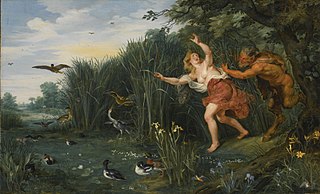
Jan Brueghelthe Younger was a Flemish Baroque painter. He was the son of Jan Brueghel the Elder, and grandson of Pieter Bruegel the Elder, both prominent painters who contributed respectively to the development of Renaissance and Baroque painting in the Habsburg Netherlands. Taking over his father's workshop at an early age, he largely painted the same subjects as his father in a style which was similar to that of his father. He gradually was able to break away from his father's style by developing a broader, more painterly, and less structured manner of painting. He regularly collaborated with leading Flemish painters of his time.
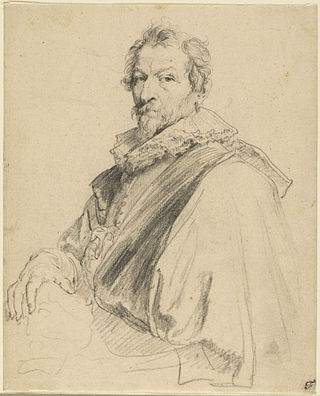
Hendrick van Balen or Hendrick van Balen I was a Flemish Baroque painter and stained glass designer. Hendrick van Balen specialised in small cabinet pictures often painted on a copper support. His favourite themes were mythological and allegorical scenes and, to a lesser extent, religious subjects. The artist played an important role in the renewal of Flemish painting in the early 17th century and was one of the teachers of Anthony van Dyck.
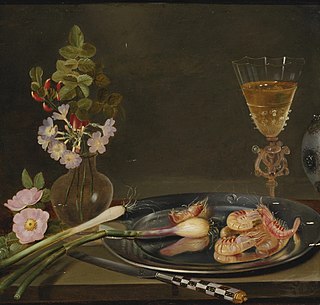
Frans Ykens was a Flemish still life painter active in Antwerp and Brussels in the 17th century. He is mainly known for his flower pieces and fruit still lifes and also painted banquet pieces, pronkstillevens, garland paintings and larger game pieces.
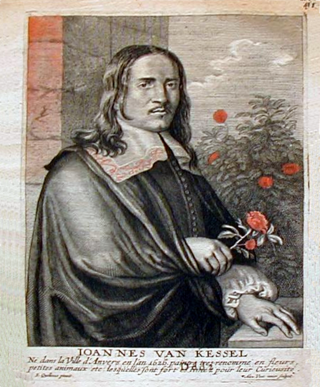
Jan van Kessel the Elder or Jan van Kessel (I) (baptized 5 April 1626, Antwerp – 17 April 1679, Antwerp) was a Flemish painter active in Antwerp in the mid 17th century. A versatile artist he practised in many genres including studies of insects, floral still lifes, marines, river landscapes, paradise landscapes, allegorical compositions, scenes with animals and genre scenes. A scion of the Brueghel family many of his subjects took inspiration of the work of his grandfather Jan Brueghel the Elder as well as from the earlier generation of Flemish painters such as Daniel Seghers, Joris Hoefnagel and Frans Snyders. Van Kessel’s works were highly prized by his contemporaries and were collected by skilled artisans, wealthy merchants, nobles and foreign luminaries throughout Europe.
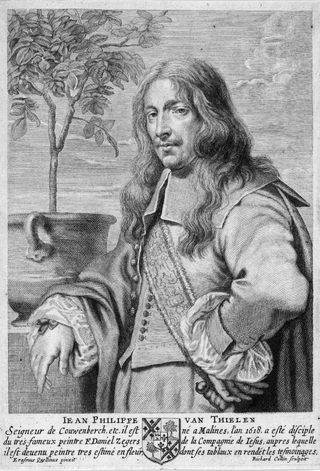
Jan Philip van Thielen or Jan Philips van Thielen was a Flemish painter who specialized in flower pieces and garland paintings. He was a regular collaborator with leading Flemish and Dutch figure painters of his time. Van Thielen was the most popular flower painter in Flanders and his patrons included Diego Felipez de Guzmán, 1st Marquis of Leganés and Leopold Wilhelm of Austria, the art-loving governor of the Southern Netherlands.
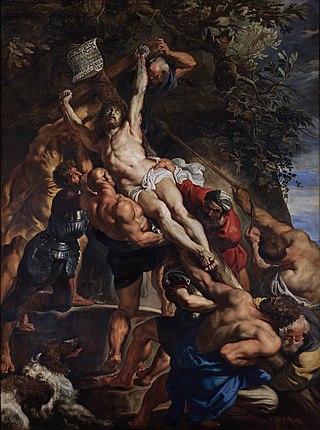
Flemish Baroque painting was a style of painting in the Southern Netherlands during Spanish control in the 16th and 17th centuries. The period roughly begins when the Dutch Republic was split from the Habsburg Spain regions to the south with the Spanish recapturing of Antwerp in 1585 and goes until about 1700, when Spanish Habsburg authority ended with the death of King Charles II. Antwerp, home to the prominent artists Peter Paul Rubens, Anthony van Dyck, and Jacob Jordaens, was the artistic nexus, while other notable cities include Brussels and Ghent.

Frans Francken the Younger was a Flemish painter who created altarpieces and furniture panels and gained his reputation chiefly through his small and delicate cabinet pictures with historical, mythological or allegorical themes. He is the best-known and most prolific member of the large Francken family of artists. Francken played an important role in the development of Flemish art in the first half of the 17th century through his innovations in many genres including genre painting and his introduction of new subject matter. He was a frequent collaborator of leading Antwerp painters of his time.
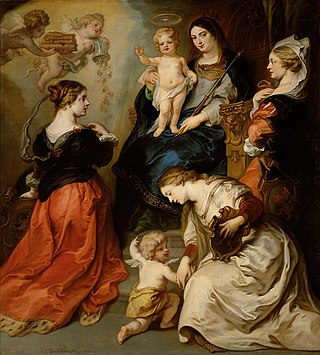
Theodoor van Thulden was a painter, draughtsman and engraver from 's-Hertogenbosch. He is mainly known for his altarpieces, mythological subjects, allegorical works and portraits. He was active in Antwerp, where he had trained, as well as in Paris and his native 's-Hertogenbosch.

Jan Boeckhorst or Johann Bockhorst was a German-born Flemish Baroque painter and draughtsman. He was a versatile artist who produced history paintings, genre scenes and portraits in a style influenced by the trio of leading Baroque painters in Antwerp Peter Paul Rubens, Anthony van Dyck and Jacob Jordaens. Boeckhorst also worked as a designer of cartoons for tapestries.
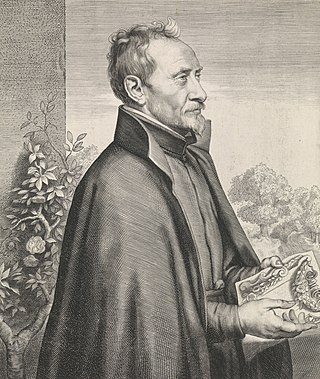
Daniël Seghers or Daniel Seghers was a Flemish Jesuit brother and painter who specialized in flower still lifes. He is particularly well known for his contributions to the genre of flower garland painting. His paintings were collected enthusiastically by aristocratic patrons and he had numerous followers and imitators.

Ambrosius Brueghel was a Flemish painter from the famous Brueghel family of artists. Less prolific and less well-known than a number of his family members, his oeuvre is not very well understood and is believed to comprise Baroque still lifes, garland paintings as well as landscapes.

Pieter van Avont or Peter van Avont, (1600–1652) was a Flemish painter, draughtsman and printmaker known for his religious scenes and cabinet paintings often including nude children and putti. Van Avont was a frequent collaborator with many leading painters in Antwerp.

Jan van den Hecke or Jan van den Hecke the Elder (1620–1684) was a Flemish Baroque painter, draughtsman, printmaker and engraver, mainly known for his still lifes, landscapes and battle scenes. After training in Antwerp, he spent time in Rome, where he had important patrons. After his return to Flanders, he worked for a while in Brussels, probably painting flower still lifes for Archduke Leopold Wilhelm of Austria, the Austrian governor of the Spanish Netherlands, before returning to work in Antwerp.
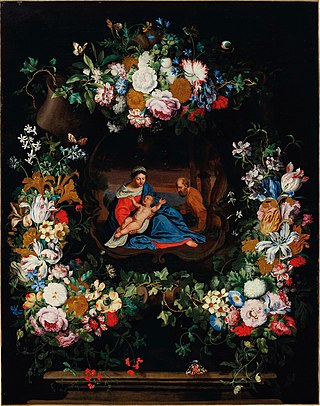
Jan Pieter Brueghel or Jan Peeter Brueghel was a Flemish painter who specialised in flower still lifes and garland paintings. A scion of the famous Brueghel family of painters, he trained in Antwerp with his father and later worked in Liège, Paris and Italy.
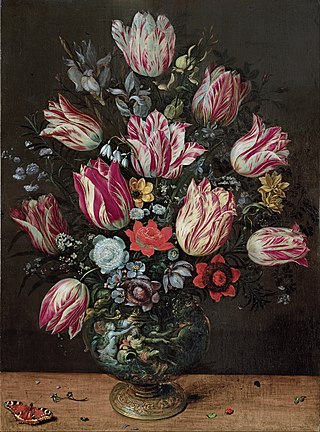
Andries Daniels was a Flemish painter who was active in Antwerp during the first half of the 17th century. He is known for his flower still lifes and garland paintings, a genre of still life paintings that he helped develop in Antwerp.
Hendrick van Balen II or Hendrick van Balen the Younger was a Flemish painter.

Philips de Marlier was a Flemish Baroque painter and copyist mainly known for his still lifes of flowers and garland paintings.

Joannes Hermans, called Monsú Aurora, was a Flemish painter of animals and still lifes of game, fruit and flowers who worked in Italy and Antwerp where he contributed to the development of the Baroque still life genre.
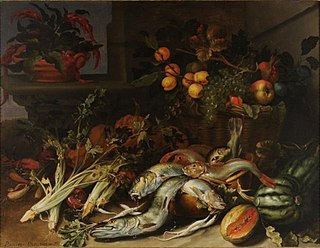
Philips Brueghel was a Flemish painter and printmaker. He painted still lifes, history paintings and landscapes. A scion of the famous Brueghel family of painters, he trained in Antwerp with his father and later worked for some time in Paris.